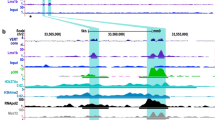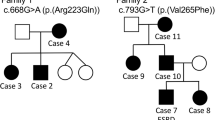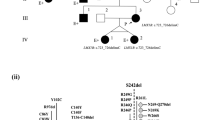Abstract
The LMX1B gene, encoding a protein involved in limb, kidney and eye development, is mutated in patients affected by Nail–Patella syndrome. Inter- and intrafamilial variability is common in this disorder for skeletal abnormalities, presence and severity of nephropathy and ocular anomalies. Phenotypic variability might depend on interactions of the LMX1B causative gene with other genes during development of both kidney and eye, which might act as modifier genes. Results are presented on the interaction between LMX1B and PAX2 proteins, obtained by both direct yeast two-hybrid assay and coimmunoprecipitation. Such interaction provides support to further studies on pathways underlying important developmental processes.
Similar content being viewed by others
Introduction
The Nail–Patella syndrome (NPS) (MIM 161200), or osteo-onycodysplasia, is an autosomal dominant disorder in which typical symptoms such as nail dysplasia, absent or hypoplastic patellae, iliac horns, can be associated to nephropathy (48% of cases), and, less frequently, open angle glaucoma (OAG); recently, in a large clinical study, peripheral neurological symptoms have been reported in 25% of patients.1, 2 The LMX1B gene is responsible for the NPS and for NPS associated with OAG, and it encodes a LIM-homeodomain protein.1 A wide inter- and intrafamilial variability has been described for skeletal abnormalities, presence and severity of nephropathy and ocular anomalies. No significant genotype–phenotype correlation has been reported.1 The LMX1B gene plays a pivotal role in embryo development in particular for limb development, kidney morphogenesis and development of the anterior segment of the eye.3, 4, 5 Phenotype variability might well be ascribed to interactions with other developmental genes, especially considering the properties of the LMX1B gene, whose LIM domain favors protein–protein interaction. Therefore, to approach this item, we have used the yeast two-hybrid system in order to test candidate gene products for their ability to interact with LMX1B. Previous work in our laboratory, carried out by the use of yeast two-hybrid screening, led to detection of the CLIM2 gene as a LMX1B interactor.6
Here, we report results on a yeast two-hybrid assay based on candidate genes interaction. Genes were considered candidate basing on the knowledge of some steps of kidney and eye embryonal development, of expression pattern and of organ and tissue abnormalities in NPS. One of the candidates we chose for a direct interaction test with LMX1B was PAX2, for the following reasons: Pax2 has a remarkable district- and stage-specific expression pattern during kidney development;7 it plays an important role in eye development;8 in humans, PAX2 is mutated in patients with renal-coloboma syndrome, a rare autosomal dominant disorder, with ocular and renal malformations9 and in patients with oligomeganephronia,10 a rare congenital and usually sporadic anomaly, characterized by bilateral renal hypoplasia, with a reduced number of enlarged nephrons; PAX2 expression is deregulated in patients with human kidney malformations and nephropathies in which the gene, normally not expressed, becomes expressed;11, 12 additional sites of expression were observed in the central nervous system in which murine Lmx1b is required for the differentiation and migration of neurons within the dorsal spinal cord.13
Here, we present results proving the interaction between LMX1B and PAX2, obtained by both direct yeast two-hybrid assay and coimmunoprecipitation experiments.
Materials and methods
Yeast two-hybrid assay
The full-length cDNAs were inserted in the appropriate vectors, pGBT9 vector (Clontech) for LMX1B and pACT2 (Clontech) for PAX2 and utilized in a yeast two-hybrid assay as bait and prey. The constructs obtained, after PCR amplification with oligonucleotide primers designed to contain restrictions sites, BamHI at the 5′ end and BglII at the 3′ end for LMX1B, and containing XhoI and EcoRI for PAX2 were cotransformated in yeast cells (CG1945 yeast strain). Transformed yeast cells were plated on synthetic medium lacking leucine, tryptophan and histidine and containing 8 mM 3-aminotriazole, according to the Clontech technical bulletin. Positive clones were also lacZ+ when tested by β galactosidase assay. We have also repeated our experiments using another yeast two-hybrid assay in which the MAV203 yeast strain was used: this strain is genetically modified to contain three GAL4 inducibile reporter genes, HIS3, URA3 and LacZ, stably integrated in the genome (ProQuest Two Hybrid System, Invitrogen). The bait construct was prepared by cloning LMX1B in the pDBLeu vector, after PCR amplification with oligonucleotide primers designed to contain restrictions sites, SalI at the 5′ end and NotI at the 3′ end, in the appropriate positions to allow in-frame fusion with the DNA binding domain of the GAL4 transcription factor.
Two deletion constructs of LMX1B in the pDBLeu vector have been prepared. Construct del1 encoding the protein fragment from residue 25 to residue 152 includes LIM-A and LIM-B domains and lacks the homeodomain, while construct del2 encodes the protein fragment from residue 229 to residue 372, lacking the two LIM domains and retaining the homeodomain. To test interaction with these deletion constructs, PAX2 was cloned in the pPC86 vector after PCR amplification with oligonucleotide primers designed to contain restrictions sites, SalI at the 5′ end and SacI at the 3′ end.
Mammalian cell expression and coimmunoprecipitation
The LMX1B cDNA was cloned in the pCDNA 3.1/myc-His expression vector (Invitrogen) containing the myc and polyhistidine epitope tags, after PCR amplification with oligonucleotide primers designed to contain restrictions sites BamHI at the 5′ end and XhoI at the 3′ end; the PAX2 encoding cDNA was cloned in the pCMV-2C vector (Stratagene), containing the Flag epitope tag, after PCR amplification with oligonucleotide primers designed to contain restrictions sites, BamHI at the 5′ end and NotI at the 3′ end.
Cos7 cells, grown in Dulbecco's modified Eagle's medium with antibiotics and 10% (v/v) fetal bovine serum, were transiently transfected or cotransfected with LMX1B and PAX2 expression vectors using the PolyFect reagent (Quiagen), according to the manufacturer's instructions. Samples of 1.6 × 106 cells were cotransfected in 10 cm plates using a total of 5 μg plasmid DNA. Cell exctracts were prepared after lysis with an NP40 containing buffer, following a protocol suggested by the Invitrogen manufacturer. Antibodies used were an anti-myc rabbit polyclonal antibody (Invitrogen) and a mouse anti-Flag monoclonal antibody (Sigma). Samples obtained after immunoprecipitation were analyzed by SDS-PAGE and Western blot. HRP conjugated secondary antibodies, anti-mouse and anti-rabbit, were used at 1:5000 dilution and the antigen–antibody complexes visualized using the enhanced chemiluminescence reaction (Amersham Pharmacia Biotech).
Results and discussion
The full-length LMX1B human cDNA fused in frame with the DNA binding domain of GAL4 and the PAX2 human cDNA fused in frame with the GAL4 activation domain were used for cotransformation in yeast in a direct two-hybrid assay. Positive colonies were observed in the selective histidine lacking medium and these same colonies were positive for beta galactosidase staining, as shown in Figure 1a.
Interaction between the PAX2 and LMX1B proteins by the yeast two-hybrid method. (a) Positive beta galactosidase staining observed in Trp+, Leu+, His+ colonies compared with negative control; (b) scheme of the LMX1B protein domains showing the two LIM- and the homeo-domain and underlined, the size of deleted constructs; (c) interaction of wt and deleted LMX1B protein with PAX2.
These results were confirmed by two-hybrid assay carried out with a different system (see Materials and methods) in which different plasmids and different yeast strain were utilized.
To further test the LMX1B/PAX2 interaction, we performed coimmunoprecipitation experiments after transfecting both LMX1B and PAX2 cDNAs in expression plasmids with different epitope tags using antibodies anti-myc for LMX1B and anti-Flag for PAX2. Extracts of Cos-7 cotansfected cells were analyzed by Western blot after immunoprecipitation: when proteins immunoprecipitated with anti-myc antibody were analyzed, a band of the expected molecular weight was detected by staining with anti-flag antibody and the opposite was observed after immunoprecipitaion with anti-flag antibody, as shown in Figure 2a and b. Therefore, both genetic and biochemical assays provided support to our hypothesis of interaction between the LMX1B and PAX2 proteins. These two proteins are abundantly expressed during kidney development; therefore, it is possible to envisage interaction at some embryonal stage although the peaks of expression are not exactly overlapping. Coexpression has also been described in the central nervous system during dopaminergic and GABAergic neuronal differentiation.14, 15
We used the yeast two-hybrid assay also to map the interaction domain of LMX1B: two deletion constructs (Figure 1b), the first including LIM-A and LIM-B domains and lacking the homeodomain, the second lacking the N-terminal half of the coding region, and therefore including the homeodomain and lacking LIM-A and LIM-B domains.
Results of the assay showed that deletion 1 virtually abolished the interaction of LMX1B with PAX2 whereas deletion 2 induced only a mild reduction of interaction, based on lacZ staining of several repeated assays (Figure 1c). This result clearly indicates an important role of the LMX1B homeodomain not only for DNA binding as already reported1 but also for the interaction with other proteins, in particular with the homeodomain PAX2 protein. The same type of interaction between homeodomain proteins, involving the homeodomain as site of interaction, has been reported in several cases.16, 17 Mutations in the homeodomain found in NPS patients may cause impairment of binding to DNA, as already reported.18 However, considering the hypothesis of modifier gene, we would not expect that they cause abolition of binding to an interacting protein, since phenotypic variability is observed between individuals within the same family. Rather we would expect that variants in the interacting protein, likely to be polymorphic, or variable degree of its expression may influence the clinical phenotype.
Since such interaction may have important implications during development of both kidney, eye and nervous system, we conclude that our results provide support to further studies on PAX2 as a modifier gene in NPS, in which renal, eye and neurological anomalies may or may not be present.
References
Bongers EMHF, Gubler MC, Knoers NVAM : Nail–Patella syndrome. Overview on clinical and molecular findings. Pediatr Nephrol 2002; 17: 703–712.
Sweeney E, Fryer A, Mountford R, Green A, McIntosh I : Nail Patella syndrome: a review of the phenotype aided by developmental biology. J Med Genet 2003; 40: 153–162.
Morello R, Lee B : Insight into podocyte differentiation from the study of human genetic disease: Nail–Patella syndrome and transcriptional regulation in podocytes. Pediatr Res 2002; 51: 551–558.
Chen H, Lun Y, Ovchimnikov D et al: Limb and kidney defects in lmx1b mice suggest an involvement of LMX1B in human Nail–Patella syndrome. Nat Genet 1998; 19: 51–55.
Pressman CL, Chen H, Johnson RL : LMX1B, a LIM homeodomain class transcription factor is necessary for normal development of multiple tissues in the anterior segment of the murine eye. Genesis 2000; 26: 15–25.
Marini M, Bongers EM, Cusano R et al: Confirmation of CLIM2/LMX1B interaction by yeast two-hybrid screening and analysis of its involvement in Nail–Patella syndrome. Int J Mol Med 2003; 12: 79–82.
Eccles MR : The role of Pax2 in normal and abnormal development of the urinary tract. Pediatr Nephrol 1998; 12: 712–720.
Xu P-X, Zheng W, Huang L, Maire P, Laclef C, Silvius D : Six1 is required for the early organogenesis of mammalian kidney. Development 2003; 130: 3085–3094.
Eccles MR, Schimmenti LA : Renal-coloboma syndrome: a multi-system developmental disorder caused by PAX2 mutations. Clin Genet 1999; 56: 1–9.
Salomon R, Tellier AL, Attie-Bitach T et al: PAX2 mutations in oligomeganephronia. Kidney Int 2001; 59: 457–462.
Winyard PJD, Ridson RA, Sams VR, Dressler GR, Woolf AS : The PAX2 transcription factor is expressed in cystic and hyperproliferative dysplastic epithelia in human kidney malformations. J Clin Invest 1996; 98: 451–459.
Ohtaka A, Ootaka T, Sato H, Ito S : Phenotypic change of glomerular podocytes in primary focal segmental glomerulosclerosis: developmental paradigm? Nephrol Dial Transplant 2002; 17 (Suppl 9): 11–15.
Dunston JA, Reimschisel T, Ding YQ et al: A neurological phenotype in nail patella syndrome (NPS) patients illuminated by studies of murine Lmx1b expression. Eur J Hum Genet 2005; 13: 330–335.
Simon HH, Bhatt L, Gherbassi D, Sgado P, Alberi L : Midbrain dopaminergic neurons: determination of their developmental fate by transcription factors. Ann NY Acad Sci 2003; 991: 36–47.
Cheng L, Arata A, Mizuguchi R et al: Tlx3 and Tlx1 are post-mitotic selector genes determining glutamatergic over GABAergic cell fates. Nat Neurosci 2004; 7: 510–517.
Stamataki D, Kastrinaki M, Mankoo BS, Pachnis V, Karagogeos D : Homeodomain proteins Mox1 and Mox2 associate with Pax1 and Pax3 transcription factors. FEBS Lett 2001; 499: 274–278.
Ruf RG, Xu PX, Silvius D et al: SIX1 mutations cause branchio-oto-renal syndrome by disruption of EYA1–SIX1–DNA complexes. Proc Natl Acad Sci USA 2004; 101: 8090–8095.
McIntosh I, Dreyer SD, Clough MV et al: Mutation analysis of LMX1B gene in Nail–Patella syndrome patients. Am J Hum Genet 1998; 63: 1651–1658.
Acknowledgements
This work was supported by grants from the Italian Ministry of University-FIRB to RR and the Italian Ministry of Health to RR. The secretarial assistance of Mrs Loredana Velo is greatly acknowledged.
Author information
Authors and Affiliations
Corresponding author
Rights and permissions
About this article
Cite this article
Marini, M., Giacopelli, F., Seri, M. et al. Interaction of the LMX1B and PAX2 gene products suggests possible molecular basis of differential phenotypes in Nail–Patella syndrome. Eur J Hum Genet 13, 789–792 (2005). https://doi.org/10.1038/sj.ejhg.5201405
Received:
Revised:
Accepted:
Published:
Issue Date:
DOI: https://doi.org/10.1038/sj.ejhg.5201405
Keywords
This article is cited by
-
Could the interaction between LMX1B and PAX2 influence the severity of renal symptoms?
European Journal of Human Genetics (2018)
-
Nail-patella syndrome
Pflügers Archiv - European Journal of Physiology (2017)
-
Genetics of congenital anomalies of the kidney and urinary tract
Pediatric Nephrology (2011)
-
Kidney disease in nail–patella syndrome
Pediatric Nephrology (2009)





